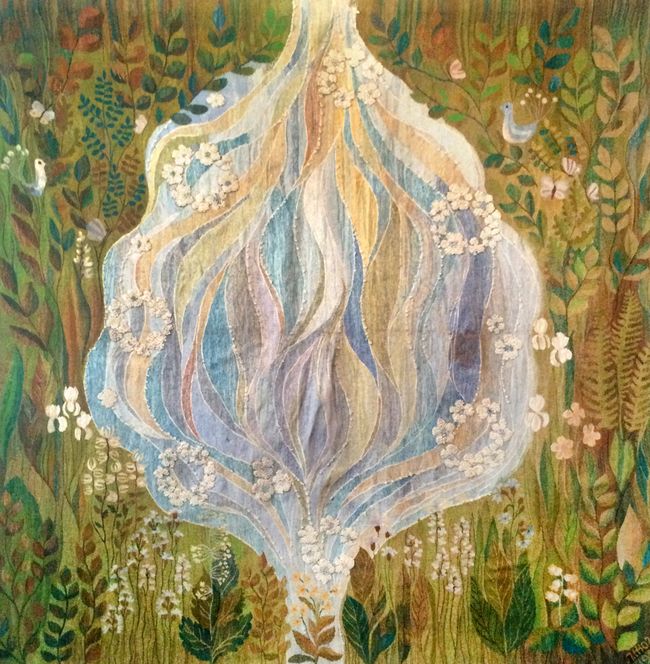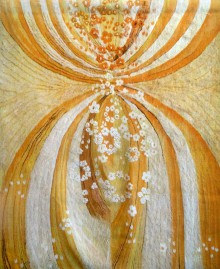The museum, which possesses the largest collection of tapestries by this outstanding Ukrainian artist (more than a hundred items), exhibits 15 monumental works to honor the memory of Liudmyla Zhohol, who passed away a year ago (one month short of her 85th birth anniversary).
For five decades Zhohol implemented her designs in floral and plant patterns on her tapestries and silk scenic curtains for interiors of public places. Simultaneously she was working (in her bright and original manner) on themed cycles which could conventionally be called “Chornobyl Disaster,” “Seasons of the Year,” “Kyiv,” and “Flowers,” where romantic, elated, and cheerful motifs dominated, with occasional dramatic strokes. The artist had a particular talent for composition, which was manifested in her works on the verge of architectural, landscape, plant ornamental, and still life genres. As a matter of fact, her genre cannot be defined as pure landscape or pure still life: it is a composite, synthetic genre, often with associative implications. Preserving the features of each of the genres, it nevertheless professes the key principles of decorative art: the generalization of the image and conventionality and planarity of the figurative picture. Zhohol’s devotedness to the classical plain weave tapestry permeates her entire artistic heritage.
Zhohol was blessed with a rare gift to find an endless variety of motifs in nature, apparently ordinary and yet suggesting nature’s throbbing life and its changeable states in various seasons, inspiring alternatively joy and melancholy.

CONSERVE NATURE / Photo illustration by the author
The artist was always fine-tuned to the subtleties of Ukrainian nature, its landscapes with all their peculiar vegetation patterns. She was always in search of new means of graphic reproduction of the fine inner connections between man and nature, thus revealing her own, original view of nature and her individual gift of poetic expression.
The painful theme of Chornobyl is a leitmotif of her art, from the fatal explosion to the early 1990s. The cycle of tapestries dedicated to the Chornobyl disaster (whose 30th anniversary we marked last April) has a clear lyrical and philosophical coloring. Her Chornobyl Cycle continues the “floral suite,” which sounded back in the late 1970s and early 1980s. But after 1986 we can see a different perception of floral motifs. The tapestries of this cycle have a strikingly acute sense of nature’s dramatic states in the clash of antagonistic forces. Despite their expressive lyrical coloring, these tapestries are more than just the reproduction of favorite landscapes or motives of nature: they render the pain in the human heart caused by a horrible disaster. Each work of this cycle has its own philosophical drama: the transition of nature “from sorrow to joy” in the triptych A New Day Will Bring New Life (1987), or the contrast in the clash of shadow and light in the tapestry First or Last Grass (1989).
In the tapestries from the cycle “Seasons of the Year,” created from 1980 to 2000, Ukrainian nature reveals its rich diversity. These works epitomize Zhohol’s masterful rendition of observations of nature and impressions into tapestries reflecting her search of textures, color combinations, and various shapes, like in Meadows in May and Summer. In her “spring and summer” tapestries from the same cycle, both from the late 20th and early 21st centuries, the theme of Ukrainian landscape remained a major one. This can be seen in the elegiac, calm composition of The Dew of Stelmakh, where Zhohol strived to create a harmonious world of thoughtful contemplation, in which you could restore your inner balance and soothe your pains.
“I was born in Kyiv in 1930, and since childhood my life wasn’t a bed of roses. At 11, war made an adult of me,” reminisced Zhohol. In 1948 Liudmyla Nedopako (that was the artist’s maiden name) went to study at the Kyiv Art Institute at the department of applied art. In 1951 the students were transferred to Lviv, to the just-created Lviv State Institute of Applied and Decorative Art, in particular, to the department of artistic textile, which the girl finished in 1954. Then followed a postgraduate course at the Academy of Architecture of the Ukrainian Soviet Socialist Republic (1954-57). Upon graduation and successful defense of her doctoral thesis, the artist worked at the Academy of Architecture, and after its reorganization, at the Academy of Construction and Architecture of the UkrSSR.
Zhohol was a talented and active person, a paragon of creative flame burning till her last breath. She made an important contribution to the development of Ukrainian decorative art in the 20th century with her theoretic research based on her extensive practical expertise. Here belong her printed publications, such as Fabrics in Interior (1968), Decorative Art in Domestic Interior (1973), Decorative Art in Modern Interior (1986), Decorative and Applied Art of the Ukrainian SSR (1986, in co-authorship), etc.
All those years she worshipped art alone, and she did it devotedly, continuously, and whole-heartedly. A proof of this could be seen in her large-scale personal exhibits in independent Ukraine, which fascinated the public with their unique beauty in many countries including Ukraine, the United Arab Emirates, Russia, Greece, Macedonia, Norway, and France; this was the triumphal path of Zhohol’s works at the start of the new millennium.
The exhibit will be open through August 12.







